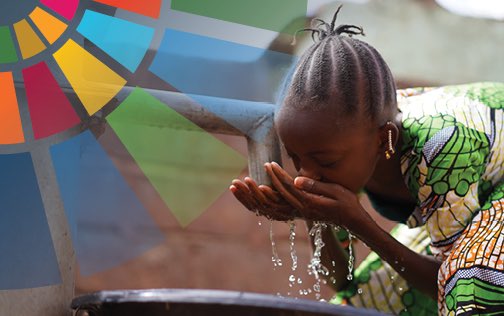Water is vital for all life and integral to the functioning and productivity of Earth’s ecosystems. Water is also central to food systems—as a basic component of food and drink, and in production, processing, and preparation of food. Another use of water, WASH (water supply, sanitation, and hygiene), is essential for human health and nutrition. Access to water and sanitation is a basic human right, like the right to food. Unfortunately, water scarcity and pollution are becoming more prevalent and affecting poorer populations disproportionately, particularly farmers. Malnutrition levels are also on the rise, particularly in rural areas, and are strongly correlated with water scarcity.
Food systems transformation is essential to achieve Sustainable Development Goal 6 on water and sanitation by 2030. Agriculture consumes most the world’s freshwater resources—currently, 85% of all freshwater withdrawals are used in agriculture, mostly for the production of cereals, sugarcane, and cotton. Nevertheless, the productivity of such irrigated systems is high—and demand for irrigation continues to grow as a result of growing climate extremes that make rainfed agriculture less resilient. Already today, irrigated crop areas produce 40% of global food on less than a third of global harvested land.
At the same time, food systems cannot be transformed without fully considering water. Around 3 billion people cannot afford a healthy diet, particularly dairy, fruits, vegetables, and protein-rich foods. These cannot be produced without access to sufficient and clean water sources. Climate change, as well as other environmental and societal changes—including land use changes, biodiversity loss, urbanization, and evolving lifestyles and diets—are affecting the dynamics of natural water cycles and water resource availability, with implications for food systems. We must reduce water vulnerabilities to successfully achieve SDG2 on zero hunger and SDG6 on water and sanitation.
Gearing up for the UN Food Systems Summit (UNFSS), a new brief on water and food systems outlines a number of solutions to jointly improve food systems outcomes and water security, including:
- Strengthen efforts to preserve water-based ecosystems and their functions. Deforestation and destruction of water-based ecosystems should be stopped, while increasing water supplies, improving water quality, and mitigating risks associated with water-related hazards and climate change. Limits to water consumption should be developed and monitored in water stressed regions.
- Improve agricultural water management for better diets for all. Climate change threatens rainfed food systems that produce the bulk of food, fodder, and fiber, as well as animal feed. Investing in more water-efficient crop varieties, improved agronomic practices, better incentives for farmers to conserve upper watersheds, and strong institutions are all key to addressing the threat climate change poses to rainfed food systems. Additionally, irrigation development should be kept in line with environmental limits. There is also huge potential for increasing water and nutrition productivity in irrigation. Finally, addressing water pollution in food production, food safety, and water-based ecosystems is pivotal to improving agricultural water management.
- Reduce water and food losses beyond the farm gate. To maximize the benefits of irrigated, perishable high-value crops such as fruits and vegetables, market linkages to consumption centers should be strengthened. This requires investing in physical infrastructure that supports on-farm production, efficient trading and exchange, value addition, and improved transportation and bulk storage.
- Coordinate water with nutrition and health interventions. Improving food security, nutrition, and health outcomes, and enhancing women’s agency, all depend on better coordination between WASH and irrigation at the government and management levels. To improve positive transmission pathways between these often competing water uses and nutrition and health outcomes, nutrition and health experts must collaborate with water managers at the farm, household, community, and government levels.
- Increase the environmental sustainability of food systems. Wide disparities exist between the water footprints of diets in rich and poor countries, and across socioeconomic groups within countries. Food-based dietary recommendations should consider the environmental impact of diets and technologies, and consumer awareness should be improved to reduce food waste and losses.
- Address social inequities in water-nutrition linkages. Vulnerable communities must be actively involved in the design and implementation of water systems. Designs should consider multiple uses of water, such as drinking, irrigation, and livestock watering, to meet the needs of rural smallholders who are most vulnerable to both water and food insecurity. With women making up a large share of the agricultural workforce, their productive roles should be promoted, and they should be trained in irrigation and water management.
- Improve data quality and monitoring for water-food system linkages, drawing on innovations in information and communications technology (ICT). To fully understand the water footprint of diets and formulate policies that co-maximize water, food security, and nutrition goals, more and better data are needed. This will help to improve water management and food systems, as well as accountability of related policy decisions. This requires long-term investments in global monitoring of a variety of hydrological and food-related parameters.
Water and food security strategies tend to be developed independently from each other, and the UNFSS Food System Summit Action Tracks have no direct focus on water. The seven solutions proposed here, however, can help shape all five tracks or focal areas and thus help to advance both the transformation of our food systems and improve water security for people and the planet.
Claudia Ringler is Deputy Director of IFPRI’s Environment and Production Technology Division, and Deputy Director of the CGIAR Research Program on Water, Land, and Ecosystems; Jenna Wilf is an IFPRI Project Intern.







